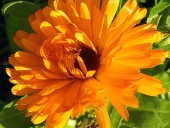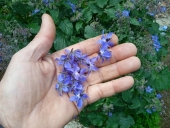
 2
2




 1
1








Ken W Wilson wrote:Do you eat the buds? Someone on here mentioned that they do, but I can't find it again. I don't think I've heard about the flowers. Mine are blooming now too, so that's an interesting question.








 1
1




William Bronson wrote:
I have proposed them as culinary canaries for testing foods. If they can eat it and survive short term,it's probably not acutely toxic.
Rabbit's resistance to toxic compounds in plants
Rabbits are resistant to some of the toxic compounds in poisonous plants. For example, rabbits are resistant to pyrrolizidine alkaloids that are the toxic principle of several plants including common ragwort (Senecio jacobea) (http://pubs.aic.ca/doi/abs/10.4141/cjas84-224) and some rabbits are resistant to the toxic effects of deadly nightshade because have high levels of plasma atropinesterase that breaks down atropine. http://www.ncbi.nlm.nih.gov/pubmed/16736160. Atropine is the toxic principle of deadly nightshade.



 20
20









Skandi Rogers wrote:
William Bronson wrote:
I have proposed them as culinary canaries for testing foods. If they can eat it and survive short term,it's probably not acutely toxic.
Do not do this! As far as I am aware rabbits can eat some things that are seriously toxic to humans without comming to any harm, Deathcaps and deadly nightshade being the worst, but they also enjoy groundsel which is also toxic.
Rabbit's resistance to toxic compounds in plants
Rabbits are resistant to some of the toxic compounds in poisonous plants. For example, rabbits are resistant to pyrrolizidine alkaloids that are the toxic principle of several plants including common ragwort (Senecio jacobea) (http://pubs.aic.ca/doi/abs/10.4141/cjas84-224) and some rabbits are resistant to the toxic effects of deadly nightshade because have high levels of plasma atropinesterase that breaks down atropine. http://www.ncbi.nlm.nih.gov/pubmed/16736160. Atropine is the toxic principle of deadly nightshade.
Plant toxicity
Back to artichoke flowers, I cannot see why not, sunflower petals are edible.





Hans Albert Quistorff, LMT projects on permies Hans Massage Qberry Farm magnet therapy gmail hquistorff
 1
1




Joseph Lofthouse wrote:I did my usual... Instead of talking about eating sunroots on the Internet, I went out to my garden, and picked a sunroot flower and put it in my mouth.
They are inedible!!!
The flower petals have spikes on them, which makes them about like eating thistles. They are fibrous, so take a lot of chewing.
With the petals being too fibrous to eat, the rest of the flower is even more fibrous. Still with the same spikes as the rest of the plant.
And that resinous taste!!! It is super concentrated in the flowers. A disgusting taste that I don't want anywhere near my mouth.
I've tried eating a lot of things that are supposedly edible, and I might eat them if I was hungry. However sunroot flowers are something that I would not attempt to eat no matter how hungry I was. Bleck. Ugh. Yuck. Spitting.

 3
3









Joseph Lofthouse wrote:I did my usual... Instead of talking about eating sunroots on the Internet, I went out to my garden, and picked a sunroot flower and put it in my mouth.
They are inedible!!!
The flower petals have spikes on them, which makes them about like eating thistles. They are fibrous, so take a lot of chewing.
With the petals being too fibrous to eat, the rest of the flower is even more fibrous. Still with the same spikes as the rest of the plant.
And that resinous taste!!! It is super concentrated in the flowers. A disgusting taste that I don't want anywhere near my mouth.
I've tried eating a lot of things that are supposedly edible, and I might eat them if I was hungry. However sunroot flowers are something that I would not attempt to eat no matter how hungry I was. Bleck. Ugh. Yuck. Spitting.
(source)
Community Building 2.0: ask me about drL, the rotational-mob-grazing format for human interactions.





 4
4




Skandi Rogers wrote:
William Bronson wrote:
I have proposed them as culinary canaries for testing foods. If they can eat it and survive short term,it's probably not acutely toxic.
Do not do this! As far as I am aware rabbits can eat some things that are seriously toxic to humans without comming to any harm, Deathcaps and deadly nightshade being the worst, but they also enjoy groundsel which is also toxic.
Rabbit's resistance to toxic compounds in plants
Rabbits are resistant to some of the toxic compounds in poisonous plants. For example, rabbits are resistant to pyrrolizidine alkaloids that are the toxic principle of several plants including common ragwort (Senecio jacobea) (http://pubs.aic.ca/doi/abs/10.4141/cjas84-224) and some rabbits are resistant to the toxic effects of deadly nightshade because have high levels of plasma atropinesterase that breaks down atropine. http://www.ncbi.nlm.nih.gov/pubmed/16736160. Atropine is the toxic principle of deadly nightshade.
Plant toxicity
Back to artichoke flowers, I cannot see why not, sunflower petals are edible.
Community Building 2.0: ask me about drL, the rotational-mob-grazing format for human interactions.














Community Building 2.0: ask me about drL, the rotational-mob-grazing format for human interactions.




"People may doubt what you say, but they will believe what you do."
 1
1




How permies.com works
What is a Mother Tree ?
 2
2




"You may never know what results come of your action, but if you do nothing there will be no result”
How Permies.com Works
Be Nice
 1
1




Permaculture...picking the lock back to Eden since 1978.
Pics of my Forest Garden
 2
2




Try Linux on your computer, free, no virus worries, stable and maintenance free. Distributions I recommend are Linux-Mint and Debian. Better than throwing your PC away when Windows rejects you.

 4
4




![Filename: sunroot-seeds.jpg
Description: Heliantus tuberosum seeds. [Thumbnail for sunroot-seeds.jpg]](/t/70643/a/100335/sunroot-seeds.jpg)
![Filename: sunroot-seedling.jpg
Description: Seedling grown from pollinated seed of Heliantus tuberosum. [Thumbnail for sunroot-seedling.jpg]](/t/70643/a/100336/sunroot-seedling.jpg)
![Filename: tps-seed-train.jpg
Description: Pollinated seeds of Solanum tuberosum. [Thumbnail for tps-seed-train.jpg]](/t/70643/a/100337/tps-seed-train.jpg)
![Filename: TPS-2015-03-15_640.jpg
Description: Seedlings grown from pollinated seeds of Solanum tuberosum. [Thumbnail for TPS-2015-03-15_640.jpg]](/t/70643/a/100338/TPS-2015-03-15_640.jpg)
 2
2




 2
2





 6
6




 5
5




Try Linux on your computer, free, no virus worries, stable and maintenance free. Distributions I recommend are Linux-Mint and Debian. Better than throwing your PC away when Windows rejects you.
 1
1




Blaine Clark wrote: I've boiled them and flowers to get broth for wine making and the boiled leaves lose the fuzziness plus they taste a lot like squash with the flowers. Add a bit of butter and you're good to chow down. I've got two varieties and one has leaves nearly three times the size of my hands, suitable for wrapping just like grape leaves for Mediterranean style or corn husks for Mexican style. They soften up when cooked though, really soft!
Blaine Clark wrote: As far as I can find, the leaves and flowers don't contain Inulin, the fart ingredient.
Dealing with the farts from the tubers, there are four ways to convert the fiber Inulin into mostly fartless fructose; freezing, fermenting, cooking in an acidic ingredient or slow cooking for around an hour.
If you want them chipped raw in salads, either toss them into the freezer for a week or so, or if your winters are cold enough to freeze them, dig them when the ground thaws. Get them before they start to sprout, when they start to sprout the flavor goes 'off'.

|
Dinner will be steamed monkey heads with a side of tiny ads.
Rocket Mass Heater Resources Wiki
https://permies.com/w/rmh-resources
|





